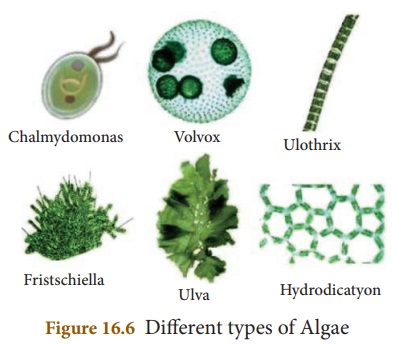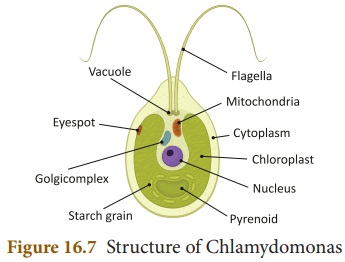Microorganisms | Chapter 16 | 8th Science - Algae | 8th Science : Chapter 16 : Microorganisms
Chapter: 8th Science : Chapter 16 : Microorganisms
Algae
Algae
Algae are very simple plant like
eukaryotic organisms. They are found in moist habitats. They are rich in
chlorophyll and can be seen as thin film on the surface of lakes and ponds.
Therefore they are known as ‘grass of water’. They are autotrophic and they
produce their own food with the help of chloroplast. Chloroplast contain chlorophyll
(green pigments) for photosynthesis. The study of algae is called algology (phycology).

Their size varies from 1 micron to
50 meter. Algae may be unicellular and microscopic (Eg. Chlamydomonas) or multicellular and macroscopic (Eg. Sargassum). Unicellular algae exhibits
variety of shapes (i.e., spherical, rod, spindle), where as multicellular algae
are in the form of filaments and branches. In this section we will study about
unicellular algae (Chlamydomonas) alone. Multicellular algae are explained in
detail in the next chapter.
Cell structure of
Chlamydomonas
Chlamydomonas is a simple, unicellular, motile
fresh water algae. They are oval, spherical or pyriform in shape. The pyriform
(pear shape) is a common one found in ponds, ditches and water tanks. They have
a narrow anterior end and a broad posterior end.
The cell is surrounded by a thin and
firm cell wall made of cellulose. The cytoplasm is seen in between the cell
membrane and the chloroplast.

The cell contains large dark nucleus lying inside the cavity of the cup shaped chloroplast. The anterior part of the cell bears two flagella which helps in locomotion. Two contractile vacuoles are seen at the base of each flagellum. The anterior side of the chloroplast contains a tiny red coloured eyespot. Chlamydomonas exhibits sexual and asexual modes of reproduction.
Related Topics